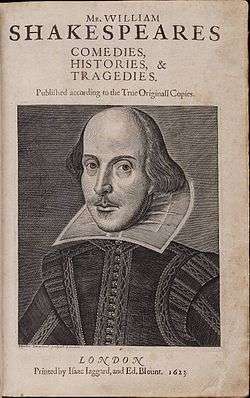Shakespeare attribution studies

Shakespeare attribution studies is the scholarly attempt to determine the authorial boundaries of the William Shakespeare canon, the extent of his possible collaborative works, and the identity of his collaborators. The studies, which began in the late 17th century, are based on the axiom that every writer has a unique, measurable style that can be discriminated from that of other writers using techniques of textual criticism originally developed for biblical and classical studies.[1] The studies include the assessment of different types of evidence, generally classified as internal, external, and stylistic, of which all are further categorised as traditional and non-traditional.
The Shakespeare canon
The Shakespeare canon is generally defined by the 36 plays published in the First Folio (1623), some of which are thought to be collaborations or to have been edited by others, and two co-authored plays, Pericles, Prince of Tyre (1609) and The Two Noble Kinsmen (1634); two mythological narrative poems, "Venus and Adonis" (1593) and "The Rape of Lucrece" (1594); a collection of 154 sonnets and "A Lover's Complaint", both published 1609 in the same volume; two passages from the manuscript play Sir Thomas More, and a few other works[2] In recent years, the anonymous history play The Reign of King Edward III (1596) has been added to the official canon, with Brian Vickers proposing that 40% of the play was written by Shakespeare, and the remainder by Thomas Kyd (1558–1594).[3]
The Booke of Sir Thomas Moore
Sir Thomas More is an Elizabethan play that depicts scenes from the life of Thomas More. It is believed that it was originally written by playwrights Anthony Munday and Henry Chettle, then perhaps several years later heavily revised by another team of playwrights, including Thomas Heywood, Thomas Dekker, and possibly Shakespeare, who is generally credited with two passages in the play. It survives only in a single manuscript, now owned by the British Library.[4]
The suggestion that Shakespeare had a hand in certain scenes was first made in 1871-2 by Richard Simpson and James Spedding, based on stylistic impressions. In 1916, the paleographer Sir Edward Maunde Thompson judged the addition in "Hand D" to be in Shakespeare's handwriting. However, there is no explicit external evidence for Shakespeare's hand in the play, so the identification continues to be debated.
A Funeral Elegy
In 1989, Donald Foster attributed A Funeral Elegy for Master William Peter to William Shakespeare based on a stylometric computer analysis of its grammatical patterns and idiosyncratic word usage. The attribution received much attention and was accepted into the canon by several highly respected Shakespeare editors. However, analyses published in 2002 by Gilles Monsarrat and Brian Vickers showed that the elegy more likely was one of John Ford's non-dramatic works, not Shakespeare's, a view to which Foster conceded.
See also
- Chronology of Shakespeare's plays
- Early texts of Shakespeare's works
- Higher criticism
- Philology
- Shakespeare Apocrypha
- Shakespeare's editors
- Textual criticism
- Stylometry
Footnotes
References
- Bate, Jonathan (1998), The Genius of Shakespeare, Oxford University Press, ISBN 978-0-19-512823-9
- Boyd, Brian; Jackson, Macdonald P., eds. (2004), Words That Count: Essays on Early Modern Authorship in Honor of MacDonald P. Jackson, University of Delaware Press, ISBN 978-0-87413-868-9
- Craig, Hugh; Kinney, Arthur F., eds. (2010), Shakespeare, Computers, and the Mystery of Authorship, Cambridge University Press, ISBN 978-0-521-51623-5
- Evans, G Blakemore (1974), Evans, G Blakemore, ed., The Riverside Shakespeare, Houghton Mifflin, pp. 27–46, ISBN 978-0-395-04402-5
- Hope, Jonathan (1994), The Authorship of Shakespeare's Plays: A Socio-linguistic Study, Cambridge University Press, ISBN 978-0-521-41737-2
- Ioppolo, Grace (2006), Dramatists and their manuscripts in the age of Shakespeare, Jonson, Middleton and Heywood: Authorship, Authority and the Playhouse, Routledge, ISBN 978-0-415-33965-0
- Jackson, Macdonald P. (2003), Defining Shakespeare: Pericles as a Test Case, Oxford University Press, ISBN 978-0-19-926050-8
- Kathman, David (2003), "The Question of Authorship", in Wells, Stanley; Orlin, Lena C., Shakespeare: An Oxford Guide, Oxford University Press, pp. 620–632, ISBN 978-0-19-924522-2
- Love, Harold (2002), Attributing Authorship: An Introduction, Cambridge University Press, ISBN 978-0-521-78948-6
- Malvern, Jack (2009), "Computer program proves Shakespeare didn't work alone, researchers claim", The Times
- Schoenbaum, S. (1966), Internal evidence and Elizabethan dramatic authorship, Northwestern University Press, OCLC 189895
- Vickers, Brian (2004), Shakespeare, Co-Author: A Historical Study of Five Collaborative Plays, Oxford University Press, ISBN 978-0-19-926916-7
- Wells, Stanley W. (2007), Shakespeare & Co., Random House, ISBN 978-0-7139-9773-6
External links
- "An Application of Authorship Attribution by Intertextual Distance in English" by Thomas Merriam
- The Claremont Shakespeare Clinic
- London Forum for Authorship Studies at the University of London
.png)